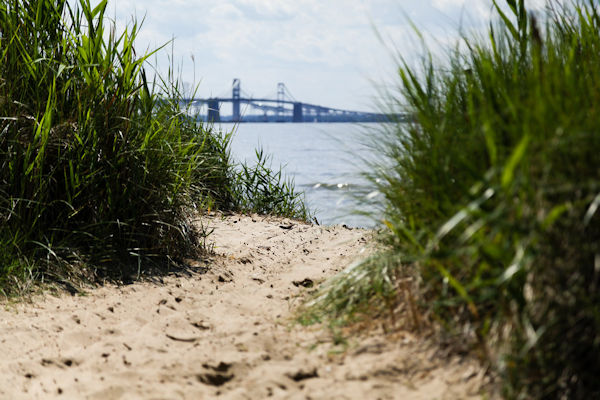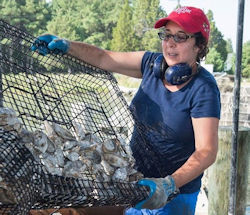SEJournal Online is the digital news magazine of the Society of Environmental Journalists. Learn more about SEJournal Online, including submission, subscription and advertising information.
 |
| The Chesapeake Bay, an example of a watershed that the author argues merits regional beat treatment, is the largest estuary in the United States, running 200 miles from Maryland to Virginia and emptying a dozen major rivers. Photo: Chesapeake Bay Program. Click to enlarge. |
Feature: Why Reporters Should Catch the Watershed by the Tale
By Rona Kobell
Watersheds don’t hold city council meetings. They won’t answer your public information request. They won’t return your calls or your emails, and you won’t be able to button-hole them in person.
But watersheds do have stories to tell, and increasingly, reporters are covering them as regional beats.
From the Source: Stories of the Delaware River is one example of a foundation-funded, newsroom-supported collaborative approach to bring to life both the people and the environmental challenges of a watershed that includes four states and serves close to 14 million people.
Another one, Good River, spotlights the Ohio, which runs 891 miles from Pittsburgh to Cairo, Ill., where it joins the Mississippi.
Funding for both of these projects came from the Lenfest Institute, based in Philadelphia, and National Geographic. Both organizations have been offering small grants to independent newsrooms as well as larger ones and freelancers to increase their environmental coverage.
Tips for covering the watershed beat
I’ve been covering a watershed as a beat since 2004, when I became the Chesapeake Bay reporter at The Baltimore Sun. I held on to the beat even as I switched jobs, in 2009, and joined the Chesapeake Bay Journal, and again, in 2017, when I joined Maryland Sea Grant as editor of our magazine, Chesapeake Quarterly.
Lenfest and Nat Geo recently asked me to lead a webinar on how to cover a watershed as a beat. This article includes many of the tips in my presentation.
► Figure out the regulatory systems.
Watersheds may not meet, but river commissions do. Who is on them? How are they chosen? What is the governing structure? Often, these groups will have monthly meetings. Try to attend, get to know members and follow up with them on any questions.
 |
| The author working on an oyster farm in Ridge, Md. Photo: Jay Fleming. Click to enlarge. |
► Use the universities.
Researchers at the universities in your watershed will be able to shed light on a new regulation, often without fear of retaliation or political fallout. For example, if the governor decreases the size limit on a popular recreational fish and the natural resources officials say it won’t harm populations, a scientist can explain that the earlier catch could cut off a large part of that fish’s reproduction, or harm the population of a mussel that might rely on it.
Always go through the public information officer, but often, they just want a heads-up, especially if you already know who you want to interview. If you have any historically Black colleges and universities in your watershed that work on these topics, get to know those researchers. They still don’t get called as much as their counterparts at the primarily white institutions.
► Ask the advocates.
Most watersheds have riverkeepers, who keep an eye out for the health of their waterways. They often will file lawsuits, join state working groups, lobby state legislatures for environmental protections or otherwise agitate for environmental protections. They are often the first “eyes” on a story, such as an oil spill or a fish kill. They don’t have to go through PIOs, and they’ll often provide reporters with cell phone numbers. Many have backgrounds in science or the law. They can walk you through complicated details.
Law clinics, too, are great places to find stories and sources to help understand environmental stories. Increasingly, recreational fishers are getting organized and agitated; find a local group in your watershed and see what they’re doing.
► Get out there.
I like to go out with commercial fishermen whenever possible. They’re on the water every day, and many have a good perspective on the problems and solutions. The ones I join on the water often have advisory roles in state commissions and have been active for a long time. You may not find yourself agreeing with their perspective, but it’s good to be aware of it. It’s also beneficial to get on boats with state officials whenever possible. On a boat, it’s hard to get away from a reporter, and you’re likely (eventually) to get questions answered.
► State agencies are still required stops.
I didn’t file a lot of Public Information Act requests in Maryland when I was a reporter – I found it easier to simply chat up my sources and ask. But when you need to do it, you need to do it, and you might find yourself writing similar requests for all of the state environmental agencies in your watershed. I file the requests, but I don’t necessarily count on them illuminating the story. By the time I get them back, I’ve already basically got what I need from interviews and other documents provided to me.
► Seek diverse sources.
I’ve always been interested in the socio-economic forces that shape our rivers and the Chesapeake Bay. I’ve long sought stories on the Black community in Baltimore as well as communities of color on the Eastern Shore, which disproportionately suffer the impacts of climate change and sea level rise. But it’s only been over the past four years or so that I’ve made a concerted effort to bring more voices from people of color into all of my stories.
It’s a challenge. If you are doing a story on the yearly blue crab survey, for example, you will want to talk to a blue crab scientist in the Chesapeake Bay. What if they are all white? You could still do your story and perhaps include a sidebar that interviews Black watermen about their reactions to the latest count. The best way to incorporate more diverse sources is to broaden the stories.
And that leaves me to my last point:
► Seek diverse stories.
I’ve said for a long time that we need to broaden the environment beat in the Chesapeake Bay. It can’t just be about oysters and crabs (though we love oysters and crabs). People of color represent 35% of our region, and yet they account for just 14% of the people who work with or for the Chesapeake Bay Program, which is the federal-state partnership that oversees the Chesapeake’s cleanup. Among leaders in the program, people of color are even more scarce – just 9%.
From my experience, many of the scientists that work on these Bay issues are also white. But the picture changes a bit when we look at public health and watersheds. If you report on hazards from poor air quality, lead in homes and water and shorter life expectancies, you are able to bring in more diverse voices as well as more diverse experts. Your stories will be better for it.
Rona Kobell is a science editor and writer at Maryland Sea Grant. She has also taught at the University of Maryland’s Philip Merrill College of Journalism, where she is now a master’s student. A former reporter at The Baltimore Sun and the Chesapeake Bay Journal, Kobell is the co-founder of an initiative focused on teaching environmental justice journalism in Baltimore high schools.
* From the weekly news magazine SEJournal Online, Vol. 5, No. 35. Content from each new issue of SEJournal Online is available to the public via the SEJournal Online main page. Subscribe to the e-newsletter here. And see past issues of the SEJournal archived here.













 Advertisement
Advertisement 



